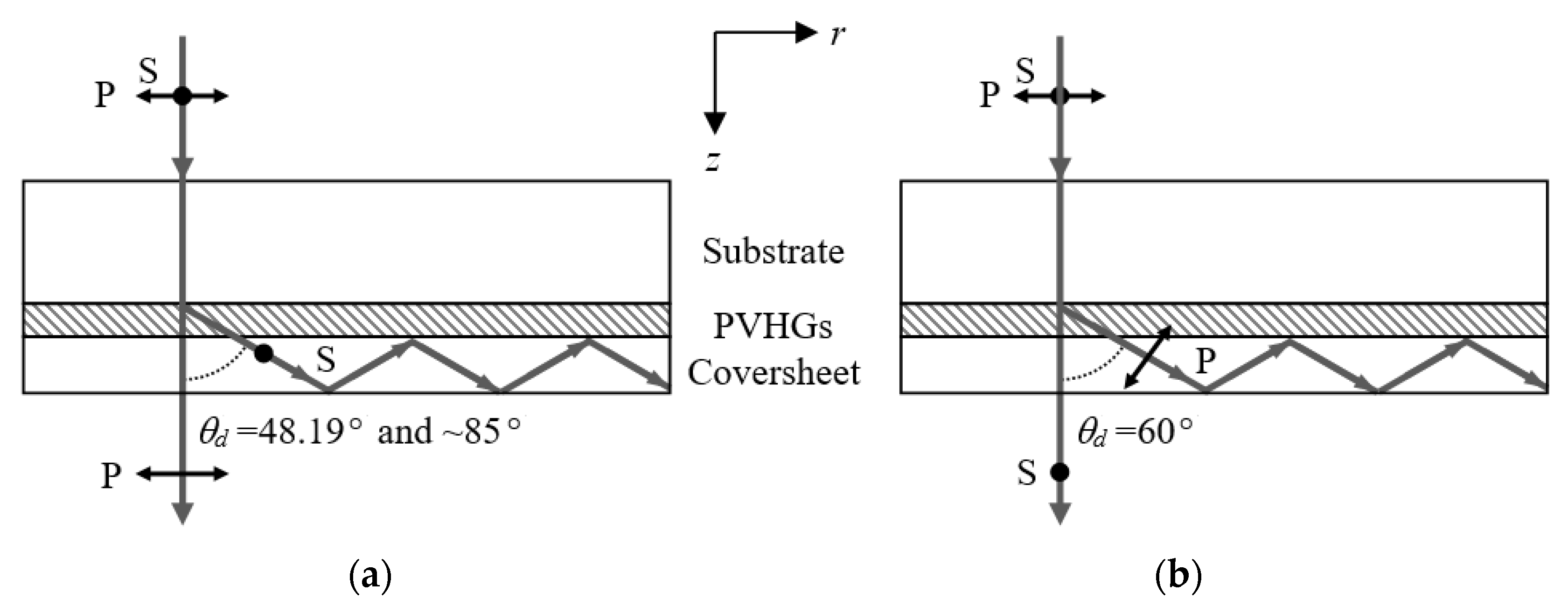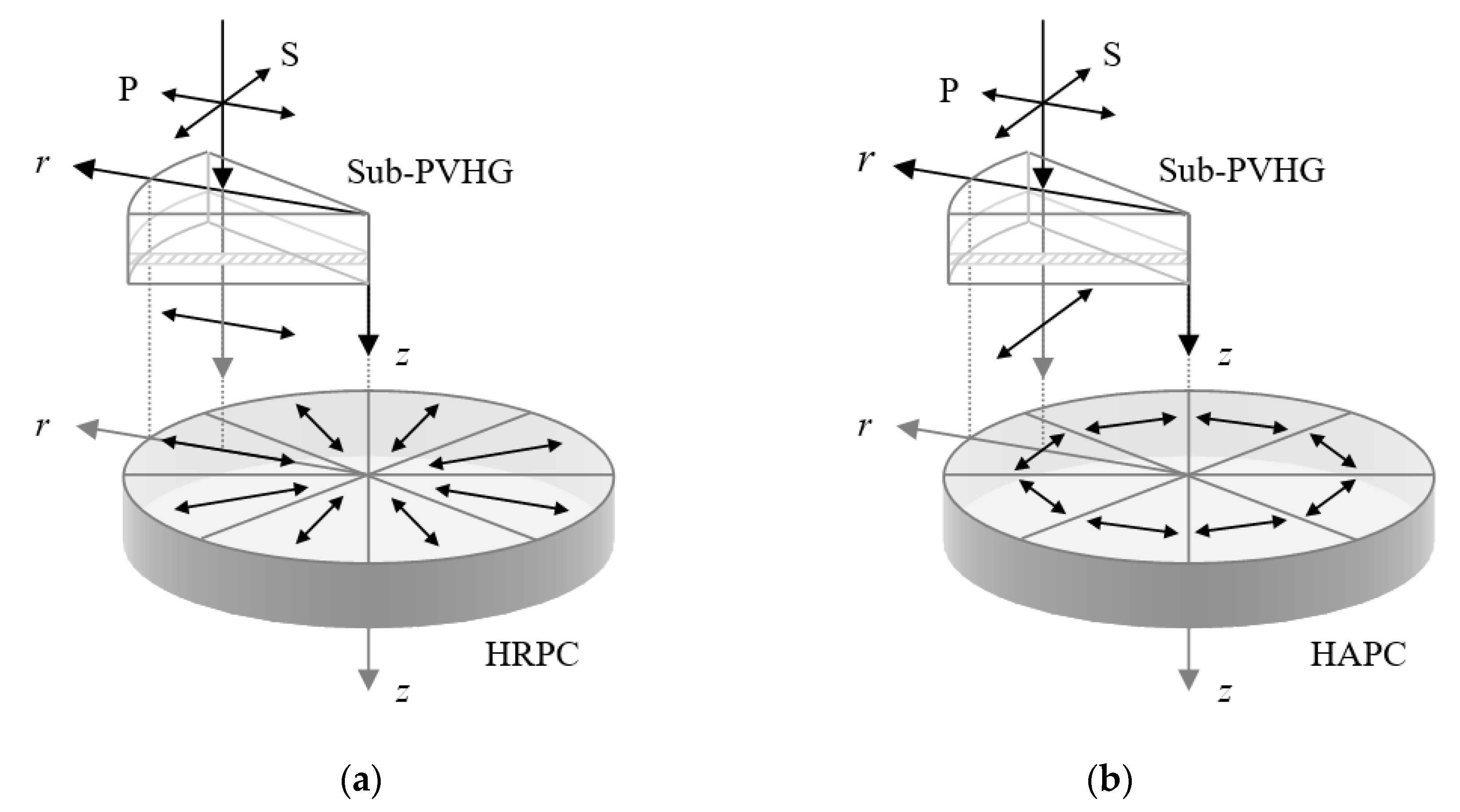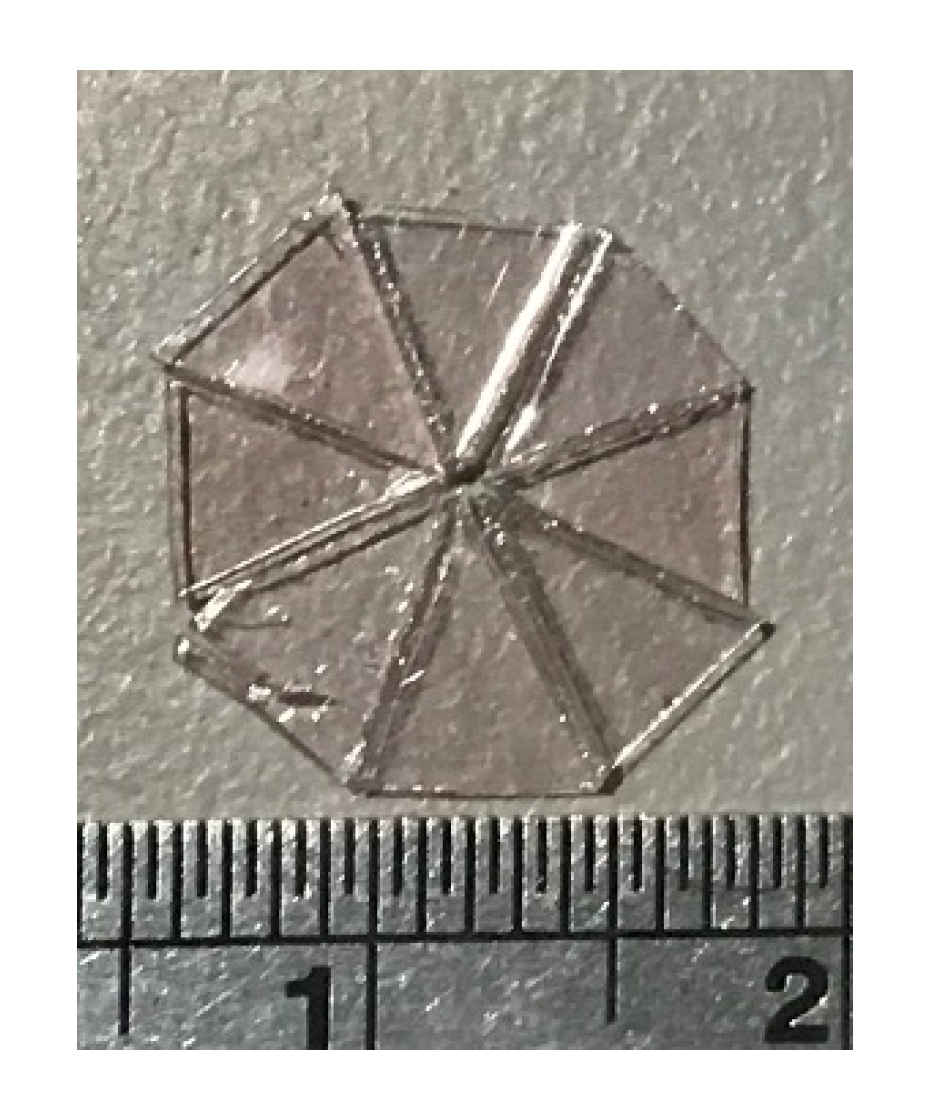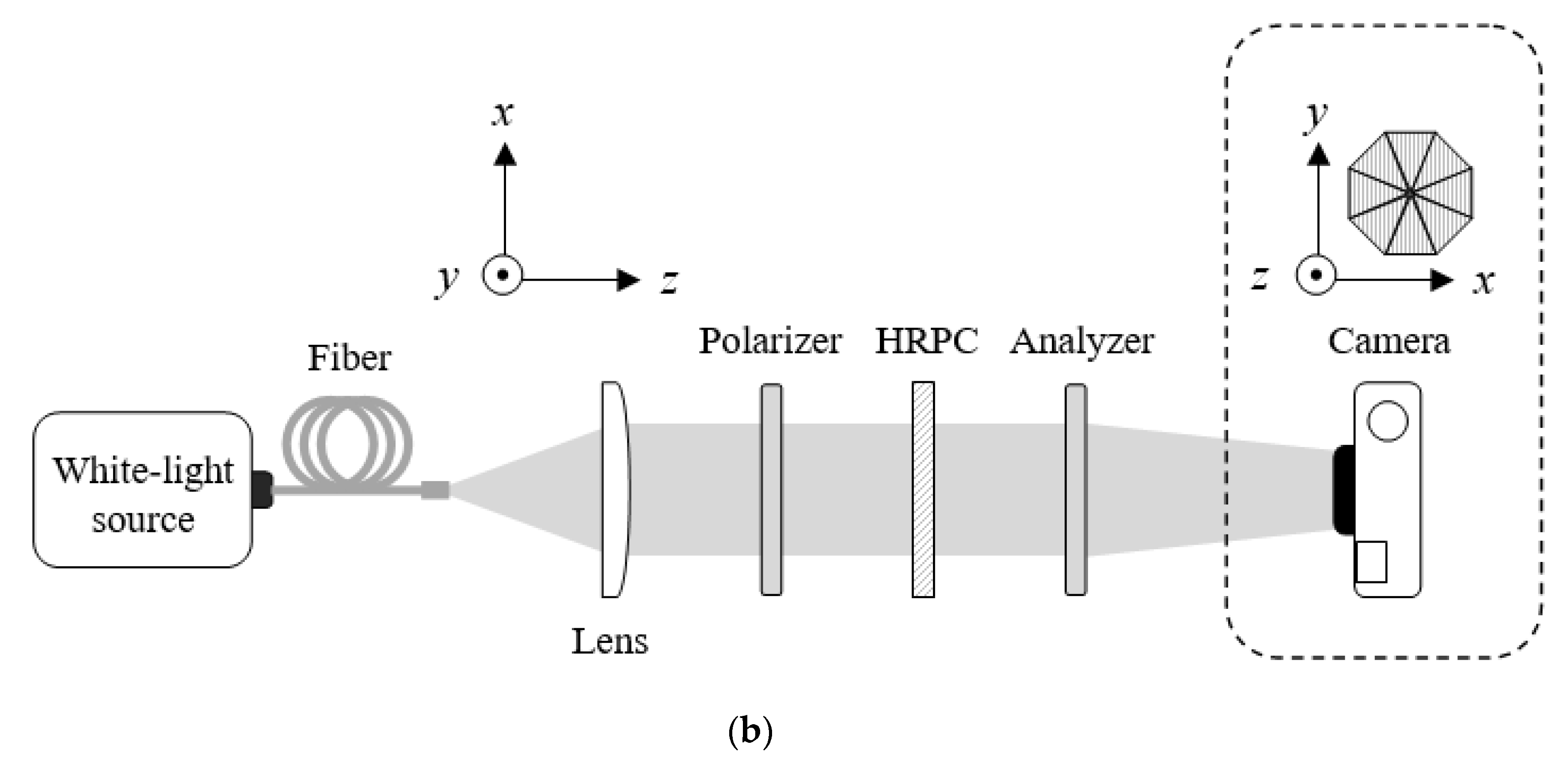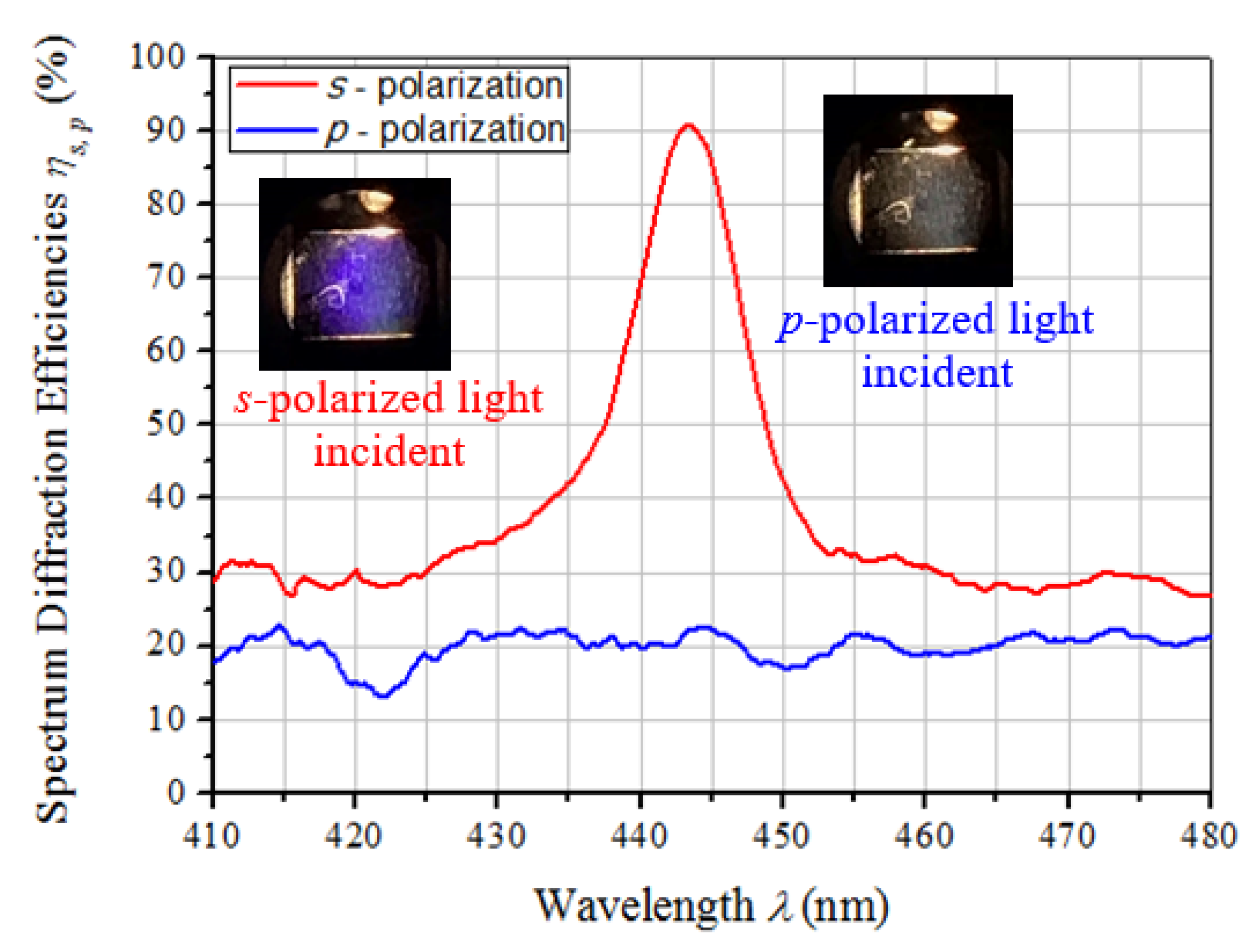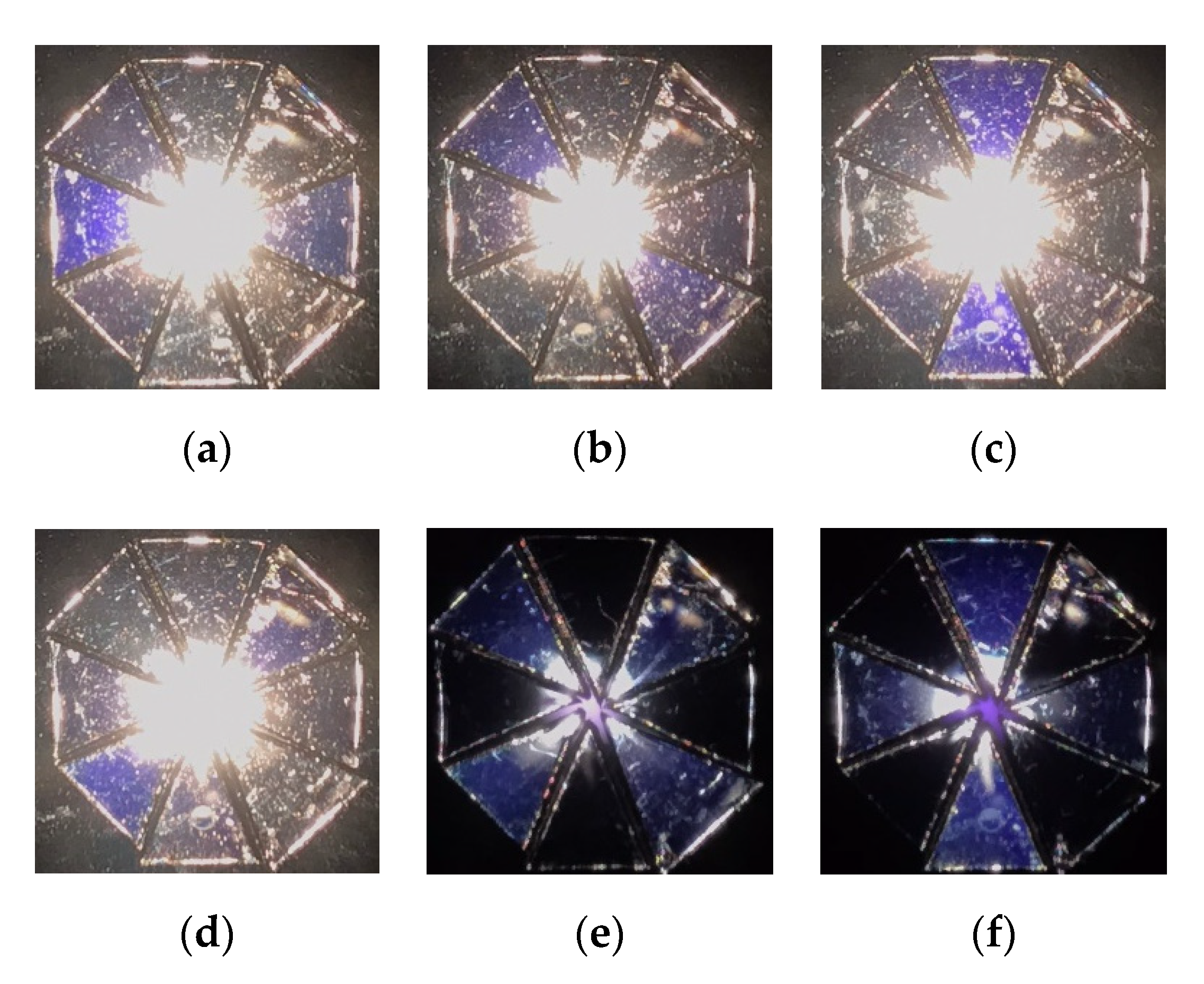1. Introduction
Radial polarization converters (RPCs) are capable of converting a linearly, circularly, or un-polarized light into radially and azimuthally polarized lights which have a variety of applications, such as high-resolution microscopy, surface plasmon excitation, optical trapping, material processing, light actuating materials, and high-density data storage [
1,
2,
3,
4,
5,
6]. Several methods have been proposed for the generation of radially and azimuthally polarized lights, which can be categorized as intra-cavity and extra-cavity methods. For the intra-cavity method, two orthogonal Hermite–Gaussian TEM
10 and TEM
01 modes are generated and superimposed inside the laser cavity to obtain the output of radially and azimuthally polarized lights. Some special designed elements, such as birefringent crystal, adjustable aperture, axicon, or non-periodic sub-wavelength gratings, are set inside the laser cavity for this purpose [
7,
8]. Due to the complexity of the cavity, the method suffers from the difficulties of alignment and additional power losses in laser manufacturing. In addition, limited by the form of laser cavity, the intra-cavity method is not suitable for fiber lasers, lithography ultraviolet (UV) lasers, or semiconductor lasers. For the extra-cavity method, it can also be divided into two types of technique. The first type of technique, similar to the intra-cavity method, uses various interferometric structures to generate and superimpose two orthogonal Hermite–Gaussian TEM
10 and TEM
01 modes outside the laser cavity [
9,
10,
11]. Therefore, this technique has high requirements for the coherence of the light source and the stability of the environment and has relatively lower power. The second type of technique uses a variety of specially designed elements, such as space-variant half-wave plates, sub-wavelength metal stripe gratings, liquid-crystal elements, dielectric metasurfaces, and waveguide gratings, to convert a linearly or circularly polarized light into radially and azimuthally polarized lights [
2,
12,
13,
14,
15,
16]. Nowadays, various commercial radial polarization converters are available. However, they may not be easy to manufacture, and therefore the cost is relatively high. By contrast, volume hologram gratings can be an alternative feasible solution for the radial polarization converter, which provide superior characteristics of high diffraction efficiency, thin and compact plane configuration, easy coupling of light, low cost, and are suitable for mass production. In recent decades, although volume hologram gratings have been successfully applied, the challenge of new applications still lies in the design and practical recording method [
17,
18]. According to the author’s knowledge, no holographic radial polarization converters have been proposed. In 2018, our research group had proposed a new prism-hologram-prism sandwiched recording method for the recording of polarization-selective substrate-mode volume holograms with a large diffraction angle which can be applied [
18].
Therefore, in this paper, a new design of holographic radial polarization converter (HRPC) is proposed for the first time. The proposed HRPC consists of eight space-variant cut polarization-selective volume hologram gratings (PVHGs). According to the coupled wave theory, the design-related parameters and manufacturing considerations of the PVHGs are described. The prism-hologram-prism sandwiched holographic recording method was adopted for the practical fabrication of PVHGs. The s- and p-polarization diffraction efficiencies of the fabricated PVHGs at 443.29 nm are 90.83% and 22.09%, respectively. With the fabricated PVHGs, a prototype HRPC was assembled and tested. The results successfully verify that the holographic radial polarization converter does have the characteristics of radial polarization. Due to the introduction of volume hologram gratings, this new element should have advantages of most holographic optical elements, meaning that it especially suitable for low-cost mass production and has high application potential in related fields.
2. Principles
The structure and operating principle of the proposed polarization-selective volume hologram gratings (PVHGs) is depicted in
Figure 1. The PVHG is attached to a substrate and covered with a coversheet. For ease of understanding, an
r-
z orthogonal coordinate system is introduced. When an un-polarized light is incident on the PVHG perpendicularly along the
z-axis, either
s- or
p-polarized light is diffracted completely by the PVHG into the coversheet with multiple total internal reflections along the
r-axis direction. Therefore, the incident plane lies in the
r-
z coordinate plane. The other polarized light is forward-transmitted through the coversheet. In this case, according to the coupled wave theory, the diffraction efficiencies of
s- and
p-polarization can be written as [
17,
19]:
where the subscripts
s and
p represent
s- and
p-polarization,
θd is the diffraction angle in the PVHG,
νs and
νp are the modulation parameters,
n1 is the refractive index modulation,
d is the thickness of hologram emulsion,
λ2 is the wavelength of reconstruction light, and
N1 =
n1d/
λ2 is the effective refractive modulation. Obviously, the diffraction efficiencies of
s-polarization and
p-polarization are two sine square functions with asynchronous oscillations. Consequently, as shown in
Figure 2a–c, the feasible diffraction angles that satisfy the aforementioned functions of PVHGs exist at 48.19°, 60°, and at a large angle around 85°, and the required values of effective refractive modulation
N1 are 1.22, 0.71, and 0.15. Under these conditions, the corresponding diffraction efficiencies (
ηs,
ηp) are (100%, 0%) at 48.19°, (0%, 100%) at 60°, and (100%, 1.93%) around 85°. Limited by the finite strength of phase modulation
n1d of recording material, a smaller effective refractive modulation
N1 is easier to implement for a specified reconstruction wavelength.
Accordingly, the architectures and operating principles of the proposed holographic radial and azimuthal polarization converters can be depicted in
Figure 3, which consist of a radially symmetrical distribution of eight fan-shaped cut sub-PVHGs with its incident plane (
r-
z coordinate plane) aligned in radial directions. As shown in
Figure 3a, a holographic radial polarization converter (HRPC) can be achieved when the diffraction angle and effective refractive modulation (
θd,
N1) are designed at (48.19°, 1.22) and around (85°, 0.15). In
Figure 3b, a holographic azimuthal polarization converter (HAPC) can be achieved when the diffraction angle and effective refractive modulation (
θd,
N1) are designed at (60°, 0.71). However, radial polarization converters are more preferred and applicable in practical applications.
3. Experimental Results and Discussions
In order to verify the feasibility of this design, a prototype holographic radial polarization converter (HRPC) was assembled and tested. Firstly, the polarization-selective volume hologram gratings (PVHGs) were recorded with photopolymer film (C-RT20, Litiholo) (
npp = 1.501, d = 16 μm) with a 632.8 nm He–Ne laser. As shown in
Figure 4, a prism-hologram-prism sandwiched recording setup was adopted for the recording [
18]. In fabrication, the photopolymer film was sandwiched between two right-angle prisms with a base angle
θp1 of 45° for recording. The collimated incident and reflected laser beams were served as a reference beam and object beam, respectively. Then, the fabricated PVHG was cut into eight sub-PVHGs with an isosceles triangle shape which were used to assemble the prototype of HRPC, as shown in
Figure 5. The dimensions of base × height of each sub-PVHG were approximately 5.0 × 6.0 mm, and the diameter of the assembled HRPC was about 12 mm. The fabricated PVHG and assembled HRPC were tested with a linearly polarization-controlled tungsten halogen white-light source (HL-2000, Ocean Optics), as shown in
Figure 6. As displayed in
Figure 6a, combined with spectrometer (HR4000CG-UV-NIR, Ocean Optics), the polarization-controlled spectrum intensities with and without PVHG were measured. Then, as shown in
Figure 7, the spectrum diffraction efficiencies for
s- and
p-polarizations at a central wavelength of 443.29 nm were determined with values of 90.83% and 22.09%, respectively, which confirmed the polarization-selective function of the PVHG. The theoretical central wavelength and diffraction angle should be 443.6 nm and 83.54°, respectively. The measured bandwidth of
s-polarization light with diffraction efficiency of 80% is about 4.42 nm. In the insets of
Figure 7, the PVHG has a purple appearance corresponding with the wavelength of 443.29 nm, when
s-polarized light is incident. This is due to the scattering phenomenon caused by multiple total internal reflections of the
s-polarized diffracted light in the polycarbonate coversheet (
npc = 1.608, d
pc= 180 μm). Meanwhile, the PVHG has a white appearance when
p-polarized light is incident.
According to the geometry of prism-hologram-prism sandwiched recording setup, the reconstruction wavelength λ2 (operating wavelength) can be tuned by changing the recording wavelength
λ1 or the base angle
θp1 of applied right-angle prisms [
18]. In
Figure 8a, the relationship of reconstruction wavelength
λ2 versus recording wavelength
λ1 is depicted with relevant thickness and refractive index parameters. Considering the most commonly used commercial lasers for holography, the corresponding wavelengths are marked and summarized in
Table 1. In addition, the corresponding diffraction angles
θd are all above 81°, which can meet the requirement of a large angle in the design. In addition, different from the traditional holographic recording method, this method belongs to a technique of longer wavelength construction for shorter wavelength reconstruction. As shown in
Figure 8b, considering a specific recording wavelength of 632.8 nm, the reconstruction wavelength
λ2 (operating wavelength) can be continuously tuned form 300.05 nm to 617.73 nm when the base angle
θd of prism changes from 61.56° to 5°. In comparison, changing the base angle of prisms is a relatively more effective method than that of changing the recording wavelength, which has a larger tuning range for the operating wavelength.
Furthermore, in
Figure 6b, combined with camera and analyzer, the characteristic of radial polarization of the HRPC was tested. The captured colorful light field distributions are shown in
Figure 9. In
Figure 9a–d, both of the transmitting axes of the polarizer and analyzer were set at 0°, 45°, 90°, and 135° with respect to the
y-axis, respectively. The analyzer was added in order to increase the contrast of image. Furthermore, in
Figure 9e,f, the transmitting axes of the polarizer and the analyzer were set perpendicular to each other; meanwhile, the transmitting axes of the polarizer were aligned at 0°and 45° with respect to the
y-axis. These results successfully proved the radial polarization characteristic of the holographic radial polarization converter. In
Figure 9, the central parts of the light field distributions have strong stray light, which is caused by the uneven intensity of the beam profile of the white-light source. Because the HRPC is operated in a specific narrow band, it is not a problem in practice. In
Figure 5, the seam in the prototype is relatively rough. This problem can be easily solved by fine processing during product manufacturing and does not affect the beam quality during use. In addition, with continuously accurate fan-shaped exposures, a HRPC without a seam could be achieved.
Compared with other commercial products and holographic lithography technology [
15,
16,
20], such as space-variant half-wave plates, sub-wavelength metal stripe gratings, liquid-crystal elements, dielectric metasurfaces, and waveguide gratings, the proposed HRPC has the advantage of traditional holographic optical components, such as high diffraction efficiency, thin and compact plane configuration, easy coupling of light, low cost, and suitability for mass production. Due to the design of a large diffraction angle and the application of the prism-hologram-prism sandwiched recording method, the HRPC also has the advantages of easy implementation and a simple recording process compared to traditional holographic optical components. Listed in
Table 2 is the comparison of polarization-selective volume hologram gratings designed at various angles. This design method only needs a small modulated refractive index value to achieve a polarization selection with high diffraction efficiency. For traditional holographic recording materials, such as photopolymers, dichromated gelatin (DCG), and silver-halide gelatin, their limited modulation refractive index cause it difficult to achieve the function of polarization selection under a limited thickness. However, the design of a large diffraction angle can be easily achieved, and the manufacturing method is very easy—only requires one collimated incident beam.
